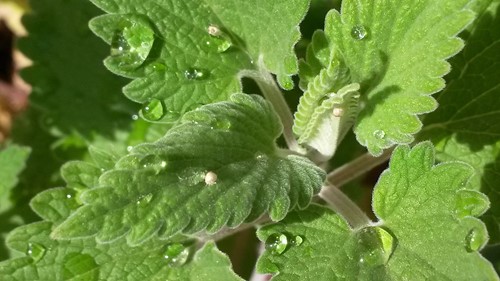
When you hear the word catnip, you probably think of the herb used in cat toys. Also called catmint, the catnip plant has many uses and helpful properties beyond exciting felines. Here are some reasons you might consider growing catnip in your garden:
One great way that growing catnip can benefit you and your garden is to use it as a companion plant. It grows quickly but does not spread like other members of the mint family do. Instead, it will create a dense, silvery-green mound of soft leaves that grows to medium height.
It’s a great landscaping plant to use as a backdrop or feature other flowers with more vibrant flowers or foliage. Because it does not send out runners, it won’t take over the entire garden or crowd out your other plants. This also makes it an excellent choice for garden edges.
Catnip is an excellent natural pest repellent. The oil from its leaves is extremely effective in keeping away flies, mosquitos and other biting insects. Planting it along walkways or nearby your outdoor seating will give you a useful plant that also has fragrant and attractive flowers during the summer and fall.
Catnip can also protect your plants against pests, particularly those who prey on vegetables like aphids, mice and rats. Deer also avoid it, which means it can work very well as a barrier plant to protect other more commonly eaten flowers and plants.
If you want to attract pollinators to your garden, catnip is an excellent choice. Catnip provides bees with a valuable and long-lasting nectar resource because it has a long blooming season. Honey bees, bumblebees and others will flock to catnip during various parts of the year to enjoy the nectar while helping with pollination at the same time. You might also see native butterflies join in the feast.
If you want to keep your garden bee-friendly, beware damage from catnip’s namesake. Because the herb is irresistible to cats, younger and less-established plants risk being trampled or grazed on before the bees can enjoy the flowers. To keep your garden both bee and cat-friendly, consider dedicating a separate fenced-off area where the catnip can grow safely without heavy feline foot traffic.
Another benefit of growing catnip in your garden is having your own supply of a minty-flavored herb with useful properties for humans. One of the key ingredients in catnip is nepetalactone, which is what makes cats excited and euphoric. For humans, it has a calming effect. This makes catnip a common addition to tea blends to reduce stress and promote good sleep. Similar to other members of the mint family, catnip has also been known to soothe digestive problems.
Catnip’s many benefits make it a favorite of gardeners all over. It’s easy to care for and an excellent choice for large landscaping projects and smaller gardens. Cats love it, bees love it and many humans love it for its pleasing scent and useful properties. Despite its many reported benefits, it’s always important to be cautious about herbal remedies, especially in combination with prescription drugs. Consult your doctor if you’re not sure, otherwise enjoy all the excellent benefits of catnip without eating it.
